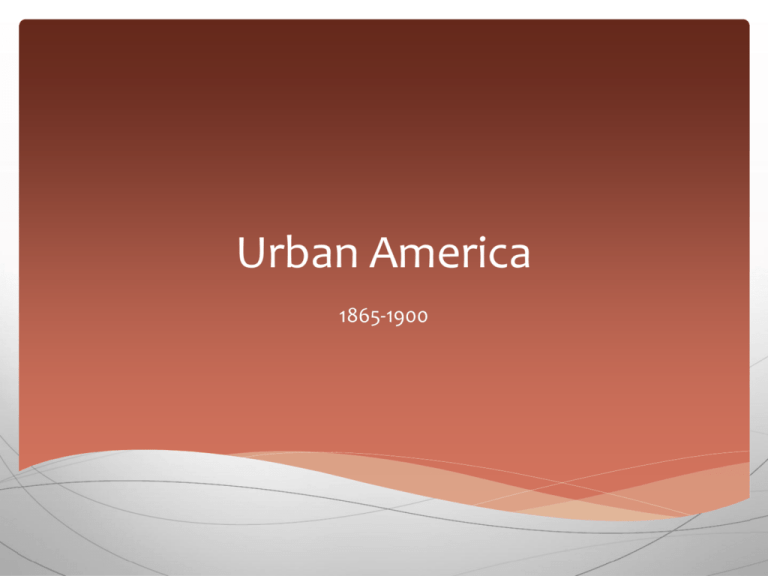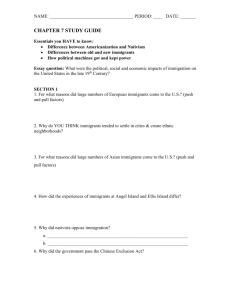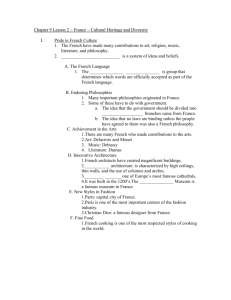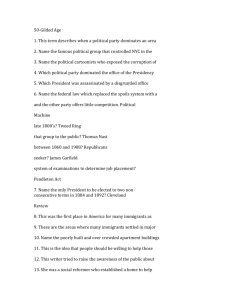ch. 21 - McEachern High School
advertisement

Urban America 1865-1900 Urban Growth The old agrarian dream Thomas Jefferson wanted America to become a nation of independent farmers. The Louisiana Purchase seemed to fulfill Jefferson’s vision of enabling America to become an agrarian republic. During the Civil War period the sturdy settler building a log cabin embodied the agrarian dream. The closing of the frontier in 1890 symbolized the end of a historic era in American history. As the western frontier experience drew to an end, a new urban frontier began to emerge. Urban Growth The new urban reality Between 1870 and 1900 urban centers assumed a dominant role in American life and culture. Just after the Civil War only one in six Americans lived in a city. By 1900 one in three Americans made their homes in cities. By 1920 a majority of the population lived in urban areas. A large number of the new urban dwellers came from small towns and rural areas. New mechanical farm equipment pushed many workers off the land. Still others wanted to exchange the drudgery of farm life for the excitement of living in cities. Electricity, indoor plumbing, telephones, and department stores all combined to make cities an irresistible magnet that promised an exciting new life. Urban Growth Industry and urban growth Before the Civil War, factories were dependent upon water for their power. As a result, they were usually built in towns near swift rivers and waterfalls. However, in the late nineteenth century, factories increasingly used steam and then electrical power. Factory owners could now build their plants near growing centers of population. During the post-Civil War period transportation centers became booming industrial cities. Meat-packing plants in Chicago, flour mills in Minneapolis, and oil refiners in Cleveland all offered jobs for unskilled workers. Urban Growth The impact of the electric trolley car New forms of transportation had a profound effect on urban life. In 1888 Richmond, Virginia successfully tested the first electric trolley system. Within two years 200 other cities opened trolley lines. By 1900, 30,000 cars carried passengers on 15,000 miles of track. The new electric street cars encouraged the growth of the central business district. They also promoted the physical expansion of cities. For the first time, employees could commute to work from a new ring of streetcar suburbs. It is important to note that these suburbs marked the beginning of a process of segregating urban residents by class, race, and ethnicity. The New Immigrants A new wave of immigration Before the 1880s most immigrants to the United States came from countries in northern and western Europe. However, the last two decades of the nineteenth century witnessed a massive wave of immigrants from southern and eastern Europe. The overwhelming majority of these “new” immigrants came from Italy, Poland, Austro-Hungary, and Russia. Europe’s new industrial economy replaced the older agricultural way of life uprooting millions of people. Most of the immigrants from Italy and southern Europe were pushed out by unemployment and crushing poverty. Jewish immigrants from Poland and Russia also wanted to escape from widespread persecution. Almost all of these uprooted people viewed America as a land of freedom and opportunity. The New Immigrants A hard new life The overwhelming majority of the new immigrants settled in large cities in the northeast and midwest. They quickly faced a grim reality that tested their optimistic faith in America and the “land of opportunity.” Many immigrants lived in crowded tenements and worked 12-hour days in grimy factories, dangerous coal mines, and dreary garmentmaking sweatshops. One Italian saying expressed the sense of disillusionment felt by many immigrants: “I came to America because I heard the streets were paved with gold. When I got here, I found out three things: First, the street weren’t paved with gold; second, they weren’t paved at all; and third, I was expected to pave them.” The bewildered immigrants often congregated into urban enclaves. The “Little Italys,” “Little Hungarys” and other ethnic neighborhoods provided close-knit communities where the new immigrants could speak their native language and practice their religious faith. The New Immigrants Immigrants and political machines Most immigrants were politically inexperienced. America’s federal system with its local, state, and national governments seemed complex and overwhelming. As a result, many immigrants became clients of big city political machines. The boss and his ward leaders provided poor immigrants with some welfare in exchange for their votes. “If a family is burned out,” explained one candid machine boss, “I don’t ask whether they are Republicans or Democrats. I just get quarters for them, bring clothes for them if their clothes were burned up, and fix them up till they get things runnin’ again. Who can tell how many votes these fires bring me?” The political machines provided the new immigrants with a rudimentary (early stage) form of welfare. At the same time, venal (corrupt) bosses often engaged in illegal schemes that cost their cities millions of dollars. New York City, for example, fell under the control of a group of corrupt politicians known as the “Tweed Ring” after their leader “Boss” William Marcy Tweed. Boss Tweed and his cronies stole as much as $200 million from the public treasury. The New Immigrants Immigrants and political machines Tweed’s reign of unbridled greed and theft finally came to an end from an unlikely source. Thomas Nast exposed Tweed’s fraudulent practices in a series of political cartoons that mercilessly portrayed the boss as the leader of a group of thieves and scoundrels. When asked why he considered Nast such a threat, Tweed replied that while immigrant voters did not know how to read, they could “look at the damn pictures.” The New Immigrants Nativist reaction The wave of Irish and German immigrants in the 1840s sparked a nativist or anti-foreign reaction among native-born Protestants. The wave of new immigrants at the end of the nineteenth century provoked a similar nativist response. The new immigrants spoke different languages, practiced different religions, and worked for low wages. Alarmed nativists accused the new immigrants of being a threat to their jobs and way of life. Francis A. Walker, president of Massachusetts Institute of Technology, summarized nativist resentment when he pronounced the newcomers “beaten men from beaten races; representing the worst failures in the struggle for existence.” The New Immigrants The Chinese Exclusion Act, 1882 Nativist resentment of immigrants was not limited to eastern and Midwestern cities. Chinese immigrants were the largest non-European group in California. Most of California’s 75,000 Chinese residents lived in sections of cities called “Chinatowns.” Working class Californians bitterly complained that Chinese laborers provided unfair competition because they worked for low wages. Proponents of immigration restriction demanded that Congress enact a law restricting Chinese immigration. Congress responded to this intense pressure by passing the Chinese Exclusion Act of 1882. The law suspended immigration of all Chinese laborers for ten years. Congress renewed the law in 1892 and then made it permanent in 1902. The Chinese Exclusion Act marked the first law enacted to exclude a specific ethnic or racial group from immigrating to the United States. Urban Reformers and the Social Gospel Jacob Riis and How the Other Half Lives Immigrant families packed into rows of squalid (filthy and wretched) tenement buildings. Landlords often squeezed a family into one airless room. A single square mile in New York City’s Lower East Side contained 334,000 people, making it the most densely populated place in the world. Jacob Riis was a journalist and photographer who exposed the poverty and despair of the Lower East Side. His book How the Other Half Lives (1890) included particularly poignant (moving) photographs of destitute families struggling to survive against overwhelming odds. Riis was not content to simply document the wretched conditions in New York’s disease ridden tenements. He hoped that his photographs would shock a complacent public into calling for reforms. Riis’s concern for the plight of the poor was not in vain. New York City tore down some of the worst slums and replaced them with new parks and playgrounds. Urban Reformers and the Social Gospel Jane Addams and the settlement house movement Jane Addams, like Jacob Riis, chose to devote her life to bettering the conditions of the urban poor. In 1889 Addams rented Hull House, an old mansion in one of Chicago’s poorest immigrant neighborhoods. Addams began by providing day nurseries for working mothers and offering adult-education classes for immigrants who wanted to learn English. As Hull House became more successful, Addams opened a reading room and installed showers in the basement. At its peak, Hull House expanded to a dozen buildings that served 2,000 people a week. Hull House served as a model for other settlement houses. Idealistic middleclass women took the lead in founding over 400 settlement houses in cities across America. Urban Reformers and the Social Gospel Walter Rauschenbusch and the Social Gospel Walter Rauschenbusch, a Baptist theologian, was deeply stirred by the plight of his parishioners in the “Hell’s Kitchen” section of New York City. Convinced that something had to be done, he advocated that the Christian principles of love and justice should be applied to the nation’s pressing urban problems. Rauschenbusch’s religious philosophy became known as the Social Gospel. Supporters of the Social Gospel believed that America’s churches had a moral responsibility to take the lead in actively confronting social problems and helping the poor. Popular Culture New forms of popular culture The last two decades of the nineteenth century witnessed the birth and growing popularity of a number of new forms of popular culture. While many of these activities were short-lived, sports generated major businesses that have endured to the present day. Professional team sports first became popular during the last quarter of the nineteenth century. Baseball began its reign as the national pastime when eight teams formed the National League in 1876. The American League followed in 1901, the two rival leagues held the first World Series in 1903. 1896 Baltimore Orioles Popular Culture Horatio Alger and the self-made man Horatio Alger was America’s most popular author of juvenile fiction. Alger was a prolific (very productive) writer who published over 100 novels which together sold more than 20 million copies. Each novel tells a formulaic (standard) story of how an impoverished young boy became successful through hard work, honesty, perseverance, and luck. Alger’s name soon became synonymous with finding fame and fortune through “luck and pluck.” Indeed, Alger believed that his novels owed their success to stories that brought to life “inspiring examples of what energy, ambition, and honest purpose may achieve.” Historians believe that Alger’s books are more than just didactic (instructive) adventure stories for young readers. His novels were written as America made the difficult transition from an agrarian to an industrial society. Alger’s stories reassured Americans that the poor but determined “self-made man” could still achieve success in an economy increasingly dominated by huge corporations. Popular Culture D. W. Griffith and The Birth of a Nation In late 1903, American audiences shrieked with shock and delight as they watched a movie called The Great Train Robbery. The popularity of The Great Train Robbery helped launched a new American industry that played a significant role in shaping popular culture. By 1916, some 25 million people a day spent anywhere from a nickel to a quarter to laugh at the zany antics of Charlie Chaplin and to fall in love with the charms of “America’s Sweetheart” Mary Pickford. By 1915 movies had become America’s fifth largest industry, and Hollywood had become the center of movie production. D.W. Griffith quickly established himself as Hollywood’s most innovative and controversial director. Griffith’s epic movie The Birth of a Nation was Hollywood’s first blockbuster film and the highest grossing movie of the silent film era. Although The Birth of a Nation was a triumph of cinematic art, it is best remembered for its glorified depiction of the rise of the Ku Klux Klan after the Civil War. Griffith’s movie helped inspire the resurgence of the Ku Klux Klan in the 1920s. Realistic Art and Literature A new realism Romanticism dominated American art and literature during most of the nineteenth century. However, the twin forces of industrialization and urbanization created harsh new social realities that conflicted with Romanticism’s emphasis upon nature. A talented group of American artists and authors rejected Romanticism turning instead to Realism’s hardedged portraits of urban life. Realism’s artists and authors focused on the facets of the modern world they could personally experience. Idealized landscapes and sentimental love stories seemed out of touch with America’s raw and raucous (loud and jarring) cities. Realistic Art and Literature The Ashcan School of Art Ashcan artists wanted above all to connect with the crowds and congestion in New York City. They relished bring part of the city’s vibrant and unruly life. Ashcan artists typically portrayed working class taverns, bleak tenements, and dark alleys. For a famous example of Ashcan art see Cliff Dwellers by George Bellows. Ashcan artists prided themselves on being young and urban. The 1913 Armory Show in New York City exposed American artists for the first time to Europe’s revolutionary Cubist and Modern artists. After touring the exhibit, Stuart Davis, a leading Ashcan artist, called the show “the greatest single experience…in all my work.” The Armory Show marked a watershed (pivotal) event that had a lasting impact upon American art. Realistic Art and Literature Realism in literature Talented authors also rejected Romanticism. They strived to create a more authentic and realistic portrayal of American life by using regional dialects and describing “true” relationships between people. Stephen Crane and Theodore Dreiser were two of America’s foremost Realist authors. Crane captured the impact of poverty in Maggie: A Girl of the Streets (1893). Dreiser’s novel Sister Carrie (1900) described the story of a young Wisconsin farm girl who moved to Chicago to pursue a new life. The Gulf Stream – Winslow Homer The Gross Clinic – Thomas Eakins New York City – George Bellows Stag at Sharkey’s – George Bellows Tennis at Newport – George Bellows McSorley’s Bar – John Sloan Nighthawks – Edward Hopper







